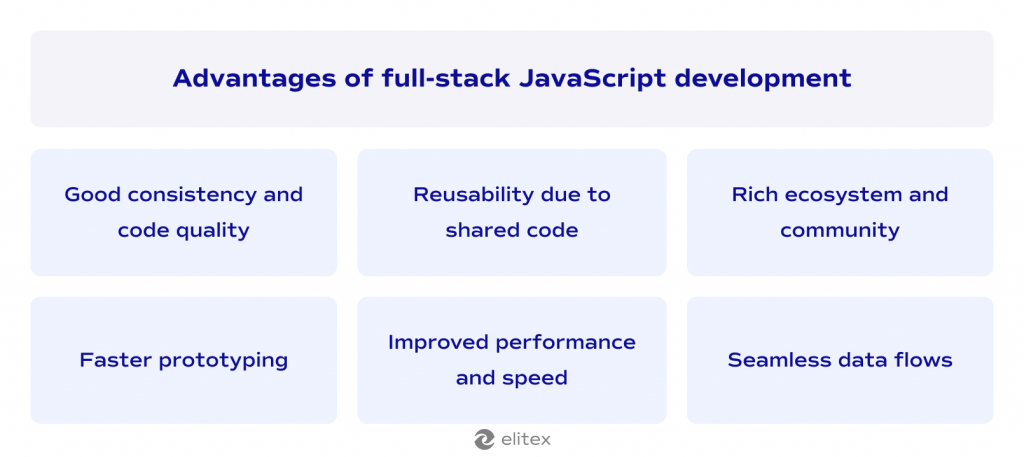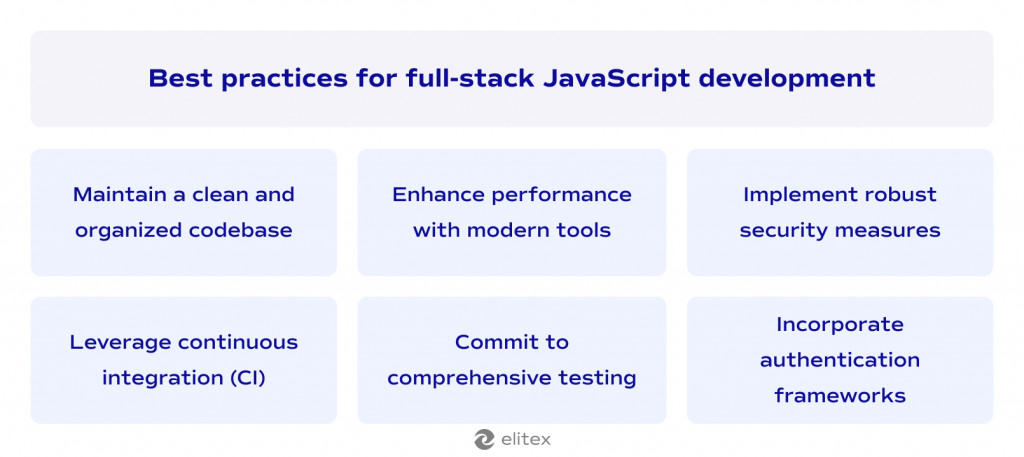- What is full-stack JavaScript development?
- Advantages of full-stack JavaScript development
- Disadvantages of full-stack JavaScript development
- Popular full-stack JavaScript frameworks
- Comparison with other full-stack technologies
- Best practices for full-stack JavaScript web development
- Hiring full-stack JavaScript web development
- FAQs
JavaScript hardly needs any introduction in 2024. As the alpha and omega of modern web development, it offers developers the versatility to handle client and server-side programming, making it a decent choice for full-stack web development. Full-stack development with JavaScript has its own advantages and drawbacks, but the fact is, its ubiquity and ongoing evolution solidify its status as an essential asset for building any complex web project.
At ELITEX, our extensive experience in full-stack web development with JavaScript includes dozens of successful real-world applications. This experience provides us with a unique perspective on JavaScript’s merits and challenges. As a professional JavaScript development services provider, we understand the nuances of using a single language across both the client and server sides of a web application. And, here, we’re happy to share our experience with you. So, without further ado, let’s explore the practical insights and future expectations of using JavaScript in diverse full-stack development scenarios together!
What is full-stack JavaScript development?
Traditionally recognized as one of the most popular front-end technologies, JavaScript expanded with the advent of Node.js, allowing it to run JS on the server side as well. Such a development, when JavaScript is involved for both front and back ends, is known as a full-stack JavaScript web development. What does it mean in practice? In practice, the whole development process can be simplified by allowing software engineers to use the same language. So again, full-stack development is a development process where JavaScript is used for both front and back ends.
What is a full-stack JavaScript developer?
A good full-stack JS developer can manage everything from the user interface (how the application looks) to the server operations. In terms of workflow, full-stack development involves designing interactive web components with front-end frameworks, such as React, Angular, Vue, or Svelte. These frameworks help in building visual aspects of a website, such as buttons, forms, and other UI elements. On the back end, a full-stack developer uses the Node.js environment to handle processing requests, databases, and other back-logic server tasks. Developers may mix JavaScript-based development tools like Express with tools like MongoDB (which supports JS through an official Node.js driver) as well as tools to connect frontend and backend seamlessly to build cohesive and fully functional web solutions.
Advantages of full-stack JavaScript development
Let’s begin by defining why using this popular language across both sides is a good idea:

Consistency across the stack
The simultaneous implementation of several programming languages adds unnecessary complexity to the project. Integrations within your web app are easier, and architecture is more straightforward with JavaScript. In this vein, using a single popular language reduces the overall code complexity and improves developer productivity.
Shared code and reusability
With the ability to share and reuse code chunks between the front and back ends, full-stack developers can leverage existing libraries and components, leading to faster development cycles and, again, better code consistency.
Rich ecosystem and community
JavaScript has a vast array of libraries, frameworks, and development tools that continue to evolve for both client and server sides. With tools like React (one of the most popular frameworks ever), finding the right tool and sharing knowledge were never issues.
Faster prototyping
JavaScript’s versatility and availability of numerous frameworks enable really rapid prototyping. Full-stack developers can quickly build and iterate on ideas, speeding up the development cycle and allowing for quick adjustments based on user feedback.
Improved performance and speed
JavaScript can be used to render the same components on both server and client sides, enabling isomorphic or universal rendering, which can improve initial load times and search engine optimization (SEO). And that’s the only particular example from the plenty of them.
Seamless data flows
JavaScript’s asynchronous nature and event-driven architecture make it easier to handle real-time data flows and bidirectional communication between the client and server sides of a web app. In practice, it translates into smoother and more intuitive user experiences.
Disadvantages of full-stack JavaScript development
However, choosing JavaScript as a full-stack development language also has the following drawbacks:

Performance limitations
JavaScript can suffer from slower performance for certain backend tasks compared to languages specifically designed for server-side operations, such as Java or Ruby.
Security risks
JavaScript’s flexibility and widespread use also make it a frequent target for security attacks. Developers need to be vigilant and implement robust and modern security measures, especially when handling users’ sensitive data.
Ecosystem complexity and heavy reliance on frameworks
The JavaScript system is vast and constantly evolving, with numerous libraries, frameworks, and tools. On one hand, keeping up with all of them can be overwhelming, leading to maintenance challenges, while on the other, language itself relies on them heavily, which can lead to potential problems and bloated code.
Debugging challenges
Debugging full-stack JS applications can be complex due to asynchronous programming and the single-threaded nature of JavaScript. Pinpointing errors on both the client and server-side can be time-consuming.
Limited flexibility
While JavaScript is versatile, some specific use cases or system-level tasks may still require specialized languages or technologies. Forcing JavaScript all over the entire stack can lead to suboptimal solutions or workarounds.
Lack of domain-specific expertise
Full-stack developers may lack deep expertise in specific domains or technologies, such as complex database systems, machine learning, or low-level system programming. This can limit the ability to tackle highly specialized or niche projects.
Popular full-stack JavaScript frameworks
There are several ways to implement full-stack JS development. Here, we will describe the most popular technologies that allow full-stack development with JavaScript, as well as combinations of tools/frameworks required to cover all development areas:

MERN (MongoDB, Express.js, React, Node.js)
- MERN is not another alternative framework but rather a combination of technologies that collectively form a JavaScript full-stack development stack.
- MongoDB is a popular NoSQL database; Express.js is a Node.js web application framework; React is a front-end library; and Node.js is a JavaScript runtime for server-side scripting.
- The MERN stack allows full-stack developers to build applications using JavaScript across the entire stack, leveraging the strength of each component together.
React/Next.js
- React is a popular JS library for front-end development, probably the biggest (in terms of community) JavaScript framework;
- Next.js is a framework for back-end development based on React, and therefore ideally compatible with it. Next enables static site generation (SSG), server-side rendering, and other features to build production-ready yet highle performant web applications.
- With Next.js, you can create full-stack applications using React for the front-end and Node.js for the back-end with built-in features like file-based routing, code splitting, and hot reloading.
Angular
- Angular is a comprehensive TypeScript-based framework developed and maintained by Google.
- Although being a primary front-end framework, it also provides complete solutions for building client side web applications, including a robust component system, dependency injection, and a powerful CLI.
- Similarly to the previous way, Angular also supports SSR through its platform-server package, allowing developers to create full-stack applications with improved performance and SEO.
Vue.js/Nuxt.js
- Vue.js is a progressive JS front-end framework for building user interfaces, known for its simplicity and ease of integration.
- Nuxt.js is a Vue.js-based framework that enables a full spectrum of features, such as SST and SSG, for building full-stack applications.
- Similarly to Next.js, Nuxt.js provides a file-based routing system, code splitting, and a modular architecture, making it a popular choice for building Vue.js-based full-stack applications.
Comparison with other full-stack technologies
Disclaimer: We have previously written our Python vs. Node.js comparison, so we will not focus on these two technologies
JavaScript vs. LAMP stack vs. Ruby
| Aspect | JavaScript | LAMP stack | Ruby on Rails |
| Primary languages | JavaScript (front and back ends); HTML, CSS for front-end | PHP (back-end), HTML/CSS/JavaScript (front-end) | Ruby (back-end), HTML/CSS/JavaScript (front-end) |
| Back-end runtime | Node.js | Apache | Ruby on Rails (or other Ruby framework) |
| Database | MongoDB, PostgreSQL, or any other database with a JavaScript driver | MySQL (traditionally) | PostgreSQL, MySQL, SQLite (commonly used with Ruby on Rails) |
| Operating system | Cross-platform | Linux (traditionally) | Cross-platform |
| Development approach | A “wholistic” full-stack JS development | Rather separate front and back developments | Ruby on Rails follows the Model-View-Controller (MVC) pattern |
| Ecosystem | Vast and rapidly growing | Mature and well-established (WordPress, Laravel, Symphony, etc.) | Mature and well-established ecosystem |
| Asynchronous programming | Inherent support | Requires additional frameworks | Requires additional frameworks |
| Real-time applications | Well-suited for real-time applications | Traditionally, not as well suited, but can be achieved with additional tools | Can be achieved with additional libraries or frameworks |
| Performance | Generally high due to Node.js and V8 engine | Highly depends on server configuration and optimization | Slower than some compiled languages but faster than interpreted languages like Python |
| Deployment | Cloud platforms, containerization (Docker) | Traditional server deployment | Cloud platforms, containerization, or traditional server deployment |
| Scalability | Highly scalable (e.g., Node.js cluster module) | Scalable with proper configuration and load balancing | Scalable with proper configuration and load balancing |
| Tooling and CLI | Robust tooling (NPM, Webpack, Babel) | Mature tooling and CLI | Provides a comprehensive set of tools and CLI |
| Templating | Client-side rendering, server-side rendering | Server-side templating (e.g., Blade, Twig) | Server-side templating with ERB (Embedded Ruby) or other templating engines |
| Testing | Jest, Mocha, Cypress | PHPUnit, Selenium | RSpec, Minitest, Capybara |
| Popularity | Gaining popularity for full-stack application development | Widely used for traditional web development | Widely used for web development, particularly in startups and agile environments |
| Use Cases | Modern web applications, real-time applications, PWAs, SPAs, | Traditional web applications, CMSs | Web apps, APIs, CMSs, e-commerce platforms, |
Best practices for full-stack JavaScript web development

Although exact strategies always depend heavily on your particular project requirements, here are some versatile tips for anyone thinking about full-stack development. A clean and organized codebase is always a solution. So, use modular coding practices to separate concerns, making it easier to manage and update individual parts of your application. Implementing features like code splitting and lazy loading with Webpack or Rollup can improve the performance of your applications by reducing initial load times.
Security is an issue in all full-stack development, not only in JavaScript-specific projects. Focus on it from the ground up. Use secure HTTP headers and HTTPS to protect data in transit when it comes to web development. Regularly update all dependencies to mitigate vulnerabilities that could be exploited in older versions. Use libraries like OAuth to handle access tokens and implement authentication and authorization securely.
Testing is key in any development process. Write tests to catch bugs early and ensure your application behaves as expected. Utilize testing frameworks like Jest or Mocha for unit tests, as well as tools like Cypress for end-to-end testing. CI systems can help automate testing and deployment processes, leading to more reliable code releases.
Hiring full-stack JavaScript web development
Full-stack development combined with JavaScript offers various benefits as well as a straightforward approach to building efficient, scalable, and visually appealing applications. When done right, leveraging a single language across both sides of your web app can reduce development time and enhance your project’s outcomes. However, seeking a reliable development partner may be quite a challenging task. In case you find yourself in a similar situation, don’t hesitate to contact ELITEX! Whether you’re looking to create a dynamic website or a complex web application using JavaScript only, need an advanced full-stack developer, or seek further web development advice, contact us. With ELITEX, you’ll always receive a product beyond your initial expectations!

FAQs
What is full-stack JavaScript?
It refers to using JavaScript for both front-end and back-end development of your application.
Which frameworks are used in full-stack JavaScript?
React, Angular, and Vue for front-end developers as well as Next and Nuxt (run in the Node.js development environment) for back-end development.
What role does Node.js play in full-stack development?
Node.js allows backend developers to run JavaScript on the server side.
Who is a full-stack developer JavaScript?
JS developer for full-stack is a developer skilled in using JavaScript for both client and server sides of web applications.
What tools does a full-stack developer JavaScript use?
Tools like Node.js, Express, React, Angular, Vue, and development aids such as Webpack, npm, and Babel are what a full-stack developer with JavaScript typically uses.
What is full-stack development suited for?
Full-stack application development is suited for complex tasks, such as rapid prototyping and web application development. It’s especially well-suited for small to medium projects and startups.






